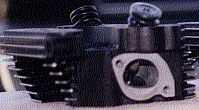| Harley-Davidson Performance Guide Cylinder Heads modifications and Porting |
|
Performance and Technical
information on cylinder heads, valves, valve sizes, valve springs, port size, port shapes
and compression ratios for Harley-Davidson motorcycles.Cylinder Head Port Shapes
All maximum effort street engines designed by the top engine designers have raised, "D"-shaped ports to maximize the air velocity. Increased air velocity is the key to excellent street performance. The difference between a set of heads with oversized ports and intake valves, against a set of raised port heads with stock valve sizes may not always show up as a difference in maximum horsepower (all other components being the same). Both engine could produce the same maximum HP, but the raised, D-shaped port heads will produce much more torque and the horsepower will occur a much lower RPM. The lower RPM range of the engine makes it much more potent on the street. You can grab a handful of throttle and the bike will strongly accelerate immediately, no waiting for the engine to "come on the cam". Guaranteed to win most of the stop light Grand Prix or highway roll-on. The key to a cylinder head design producing high horsepower is in creating high velocity air flow through the ports. This is easier to do with smaller ports rather than large ones. High velocity does a couple of things that are very positive to making power.
As you can see, a more conservative engine port design is likely to give better street performance. This type of port design will not give the big CFM numbers published by most companies that sell aftermarket heads. The average person buying a set of heads or porting job makes the assumption that bigger is better. This same assumption is applied to camshaft purchases. The 95 horsepower Stage Three engine has stock sized valves and small ports. The cam in this engine was 252 degrees of duration with a .550 lift. All very conservative numbers, considering the how many .600 lift cams with 260+ degrees of duration are made by the cam manufacturers. |
|
Do it yourself cylinder head portingBasic cylinder head porting will improve the performance of any production cylinder head by removing flaws that come through mass production. Basic porting does not attempt to correct any design or engineering deficiencies. Once your porting project turns to that, you're beyond the scope of basic porting techniques. Standard Abrasives offers a DIY Guide to porting and they can supply the required grinding and polishing bits for use with a die grinder. This information is no substitute for the experience required to do high end performance work, but it can help you improve your current performance.
|
